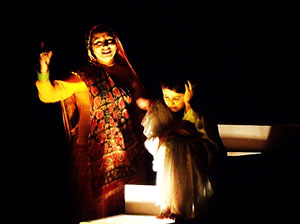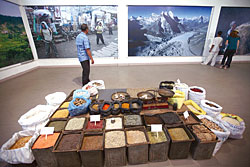 SUPRIYA SHARMA |
The play's unconventional structure, consisting of a dichotomous protagonist in a circular narrative, is ultimately refreshing; the story is kept from becoming nebulous by the lead, Nisha Sharma, who brings the show together as the flippant yet endearing Sapana.
The plot chronicles the different manifestations of Sapana's character as she journeys from home to become a young comrade after a lascivious lover heartlessly deserts her. Her character evolves slowly in front of the audience by means of two-way narrative: one conducted by Sapana herself, and the other by Drasta, played by Sanjeev Uprety, who appears to be Sapana's subconscious or alter ego.
As the translucent haze that fills the stage at the beginning of the play subsides, we see Sapana plunge immediately into different environments – at once the whimsical belle finds herself at the epicentre of battle, and then again in the home of a family that has been destroyed by the very conflict she's participating in; in lighter times, she is a schoolteacher, or is appointed as an animated traffic cop. The volatile variability of her professions carries over into her personal life, as she becomes a part of makeshift families, and flits through lovers true and false, all the while attempting to free herself from others and discover an identity that embodies the woman she is.
This deliberate variation in character and locale is reflective of Sapana's own struggle, but it is also indicative of the condition of many kinds of individuals embroiled in everyday battles, both literal and metaphorical. Ultimately, the play's success lies in Nisha Sharma's ability to engage with the audience, and her capacity for the kind of delivery that poignantly communicates the plight of those who bear witness to the realities of conflict.
Supriya Sharma
Picturing food
 |
The walls of Nepal Art Council are adorned with unique images this week. Organised by the World Food Programme, the exhibition showcases a collection of 46 photographs from 18 photographers across the country to catalogue the food culture of Nepal. The photographs capture the life-cycle of food in Nepal, through its cultivation, preparation, consumption and use in rituals. Richard Ragan, the outgoing WFP Country Representative, introduced the exhibition with the phrase, "We are what we eat", and the pictures certainly reflect this truism in the diversity of Nepali culture on show. The beautiful images also managed to communicate the grave reality of the hardships that families in the difficult terrain of Nepal face to put food on their plates. The exhibition features a collection of short documentaries, including the first-ever 3D animation made in Nepal.
The Life of Food in Nepal, 20-25 July, Nepal Art Council, Babar Mahal. Free admission
READ ALSO:
Baking hot, PAAVAN MATHEMA


